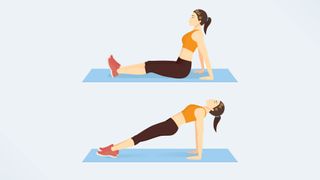Exercises that target your core and get those abs rippling have long been the focus of many when it comes to fitness. Not only for their notoriety for helping achieve a ripped beach body, but also for the ability they have to improve stability, improve posture, and optimize overall strength.
While traditional planks have become the go-to exercise for those looking to improve their core strength, there’s one related exercise that should be getting just as much attention, and that’s its lesser-known cousin: the reverse plank.
Also known as a supine plank, the reverse plank is a bodyweight exercise that engages the core muscles along the lower back, glutes, and abdominal region. It is about assuming a position similar to the traditional plank but with the body facing upwards, towards the sky, supported by the hands and heels.
But why and when would you reverse plank on a standard plank? What are its advantages and how can you do it without injuries? We’re going to tackle all of that, with the help of some fitness experts, right in this article. Read on to learn more…
Reverse Plank: What are the Benefits?
Integrating an inverted plank into your weekly training schedule is not only easy because it doesn’t require any fitness equipment, but it will bring you a multitude of benefits.
Chatting with Tom’s Guide, fitness expert, PT and chief scribe of Fitness brainJames Dixon describes reverse plank as an excellent bodyweight exercise that “just does it all.”
“The reverse plank is kind of like the unsung hero of the fitness world,” he says. “Imagine your body as a seesaw; This exercise is designed to build strength and stability in your lower back, glutes, hamstrings, and abs—basically every muscle you’d use to stay perfectly balanced on that imaginary seesaw!
By targeting and strengthening your core muscles, it engages the rectus abdominis, obliques, and transversus abdominis, which play a crucial role in providing stability and support to your spine. And the long-term benefit here is that a stronger core can improve your ability to perform daily activities, enhance athletic performance, and reduce your risk of injury over time.
The reverse plank exercise also helps combat poor posture by activating the muscles responsible for maintaining an upright position, such as the erector spinae and lower trapezius.
Second a 2022 study from the International Journal of Sports Physical Therapy, strengthening these muscles contributes to better spinal alignment, relieves back pain, and improves overall posture.
There really is no end to the benefits of this simple exercise. The reverse plank is also said to promote spinal flexibility and improve the body’s overall range of motion.
But what is the difference between an inverted board and a standard board? Overall, both exercises work the abdominal muscles, but the conventional plank targets the anterior (or anterior) muscles more while the reverse variation focuses more on the posterior chain (the muscles along the back of the body), which is why it is useful to reduce back pain.
How to perform a reverse plank
Knowing the benefits of incorporating a reverse plank into your workout routine is perfectly fine, but you’re going to get nowhere if you don’t know how to do one correctly. Doing so will not only make sure you get the most out of the exercise, but it will also help you avoid injury.
Daniel Herman, SAQ trainer and founder BioSynergy, provides us with a step-by-step guide on how to do it right:
- Start by sitting on the floor with your legs extended in front of you and your feet together.
- Next, place your hands directly under your shoulders, fingers pointing toward your feet.
- Then, press your hands together and lift your hips off the ground, creating a straight line from head to heels.
- While performing the above, be sure to engage your core and glutes while avoiding sagging or arching your back.
- Hold this position for the desired duration, aiming for 30 seconds to one minute.
- Finally, slowly lower your hips to the ground. This is a complete repeat.
Herman recommends doing 2-3 sets of 30-60 second reverse planks per workout to reap the full benefits of the exercise.
Reverse Plank: Common mistakes to avoid
If performing a reverse plank doesn’t feel right for your body, or feels too difficult or not challenging enough, there are a myriad of variations that can be done instead, all of which offer the same or similar benefits.
Product Development Manager at Total fitnessDean Zweck, recommends the following variations, all targeting the same muscles:
Single Leg Reverse Plank: Lift one leg off the ground as you perform the reverse plank to increase the challenge and engage your glutes and hamstrings more intensely.
Reverse plank with leg raises: While holding the reverse plank position, alternate lifting each leg off the ground, engaging the core and glutes while challenging stability and balance.
Reverse plank with bent knees: From the reverse plank position, bring your knees toward your chest, engaging your abs and hip flexors for an added challenge.
Reverse plank on elbows: Try the reverse plank with your arms bent rather than straight, supporting your weight on your forearms. This provides an additional challenge to shoulder flexibility and core strength.
However, Dixon adds that one of her favorites has to be the reverse plank leg lift
“This is where you lift one leg at a time while holding the reverse plank position,” she explains. This spice things up a bit, challenging your balance and further engaging your core. It’s worth mentioning that what works wonders for me may not hit the same sweet spot for you. Fitness, after all, is a very personal journey and the best exercise is what you enjoy and keep doing.
More from Tom’s Guide
#reverse #plank #strengthen #glutes #hamstrings #abs
Image Source : www.tomsguide.com
